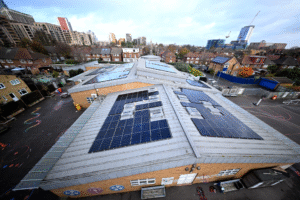With clean power projects sitting on the shelf due to major delays plugging into the National Grid, one green leader believes it’s time to break the company’s connection monopoly.
According to the Environmental Audit Committee [EAC], by the start of 2024 the UK National Grid had a backlog of around 200,000 applications for renewable energy projects. The Science Museum Group reports 400 gigawatts of infrastructure and facilities are waiting in a queue to be connected to the transmission network. And there’s now just 10 years to fully decarbonise the grid.
Clearly something’s got to give, and with many facilities being given ‘plug-in’ dates a decade or more into the future, the gridlock needs to be broken sooner rather than later. Otherwise, even with increasing investment in renewable energy development, the country will not be able to achieve its aim of running on a 100% green power grid 2035.
For John Sturman, the solution is as complex as it is simple. On the one hand, the Managing Director of renewables developer NatPower UK advocates a relatively straightforward change in planning policy to bring onshore energy projects in line with their offshore counterparts. Seen in another way, though, his proposal requires regulatory reform in a sector notoriously bogged down with red tape.
‘In terms of statements the new Labour government have made, these have been welcomed by the renewables industry. There’s a potential for a real renaissance in development of onshore wind in England which has suffered a seven year ban, the de facto moratorium introduced by the previous administration,’ says Sturman. ‘But that’s only half of the story.
‘As developers, we’re quite willing to throw capital at risk to finance a project, but we need a clearer position on being able to connect to the grid. You cannot invest significant amounts of money into the market if the grid connection of your project makes your project unfeasible. Years of under investment in infrastructure have been allowed to pass by,’ he continues.
Sturman puts the blame for this at the door of the National Grid, which he describes as ‘the monopoly owners of the transmission network’. The basic requirement of developers – to see their renewable projects plugged into the grid – is not being met. At the time of our conversation, some of NatPower UK’s proposed projects have connection dates of 2037. A two year overshoot of the Great British net zero target.
‘In terms of investment into renewables, the UK is not cash constrained. There’s plenty of capital waiting to be invested in the country. But two things are preventing this. With wind, it’s planning, and with all projects its the connection issue. And we’re talking about billions of pounds flowing into the country. So far we’ve heard about planning reforms, but nothing about a grid reform to enable competition in the transmission network, which I think is required to unlock all the investment potential and deliver projects sooner,’ Sturman tells us.
‘As far as we know, this isn’t being discussed actively at the right levels, possibly because it just hasn’t been considered. So we as a company are looking to lobby and inform the government that regulatory change would break the literal gridlock,’ he adds. ‘Offshore wind farm developers have the ability to deliver their own substation grid connection under what’s called the Offshore Transmission Owners [OFTO] regime… different companies bid on different pieces of infrastructure, and Ofgem enables that, but not for onshore.’
Although Sturman sees the change as small and quick to implement, with increasing talk of nationalisation under Labour, and a public fatigued by the shortfalls of privatised utilities and infrastructure, his the proposal to introduce a competitive grid market flies in the face of the current political mood and appetite. So will the nation need convincing?
‘It’s a very different piece of infrastructure compared to examples such as the water companies or rail network. Everyday consumers are directly related to those services. When it comes to the transmission network, they’re not. Consumers are linked to their local grid, which is already owned by private firms, like SSE, for example. This regional competitive market works in a similar way to what we are proposing.
‘What we’re proposing in terms of investment into that transmission network is private companies will take over parts of that transmission network and pay for it themselves and make their money from big generators, for instance, like the wind farms and solar parks,’ he continues. ‘And the cost of that infrastructure will not be passed on to consumers. So in effect, we are aiming to reduce consumer bills.’
Transmission network aside, Sturman also believes that nodal pricing could help bring Britain’s ageing grid and electricity infrastructure into the 21st Century – delivering localised pricing based on availability of electricity produced in the area and the need to balance the network. So in places where power generation is low, prices would be higher, which he says would help drive infrastructure development in places reliant on domestic imports. Just like the grid reforms, it’s a deceptively straightforward solution made complex by the highly restrictive rules governing the energy sector.
More features:
Water stewardship is key to a sustainable future, but lacks leadership
Dining out: West Africa’s bushmeat trade is greater threat than poaching
Image: Антон Дмитриев via Unsplash
















